brake TOYOTA TACOMA 2022 Owners Manual
[x] Cancel search | Manufacturer: TOYOTA, Model Year: 2022, Model line: TACOMA, Model: TOYOTA TACOMA 2022Pages: 616, PDF Size: 12.92 MB
Page 3 of 616

3
1
8 7 5 4
3
2
9
6
4-1. Before drivingDriving the vehicle ............. 168
Cargo and luggage............ 178
Vehicle load limits ............. 182
Trailer towing..................... 183
Dinghy towing.................... 200
4-2. Driving procedures Engine (ignition) switch (vehicles without
a smart key system) ........ 201
Engine (ignition) switch (vehicles with a smart
key system) ..................... 204
Automatic transmission ..... 210
Manual transmission ......... 215
Turn signal lever................ 217
Parking brake .................... 218
4-3. Operating the lights and wipers
Headlight switch ................ 219
Automatic High Beam ....... 223
Fog light switch ................. 228
Windshield wipers and washer ............................ 229
4-4. Refueling Opening the fuel tank cap .................................. 232 4-5. Using the driving support
systems
Toyota Safety Sense P ...... 236
PCS (Pre-Collision System)..... 244
LDA (Lane Departure Alert)..... 257
Dynamic radar cruise control ................... 265
Cruise control .................... 279
Intuitive parking assist ....... 283
BSM (Blind Spot Monitor)......... 291
• The Blind Spot Monitor function.......................... 293
• The Rear Cross Traffic Alert function ................. 296
Four-wheel drive system ... 302
AUTO LSD system ............ 306
Rear differential lock system ............................. 308
Active traction control system ............................. 311
Multi-terrain Select............. 313
Crawl Control ..................... 317
Clutch start cancel switch .............................. 321
Driving assist systems ....... 322
4-6. Driving tips Winter driving tips .............. 328
Off-road precautions .......... 332
4Driving
Page 9 of 616
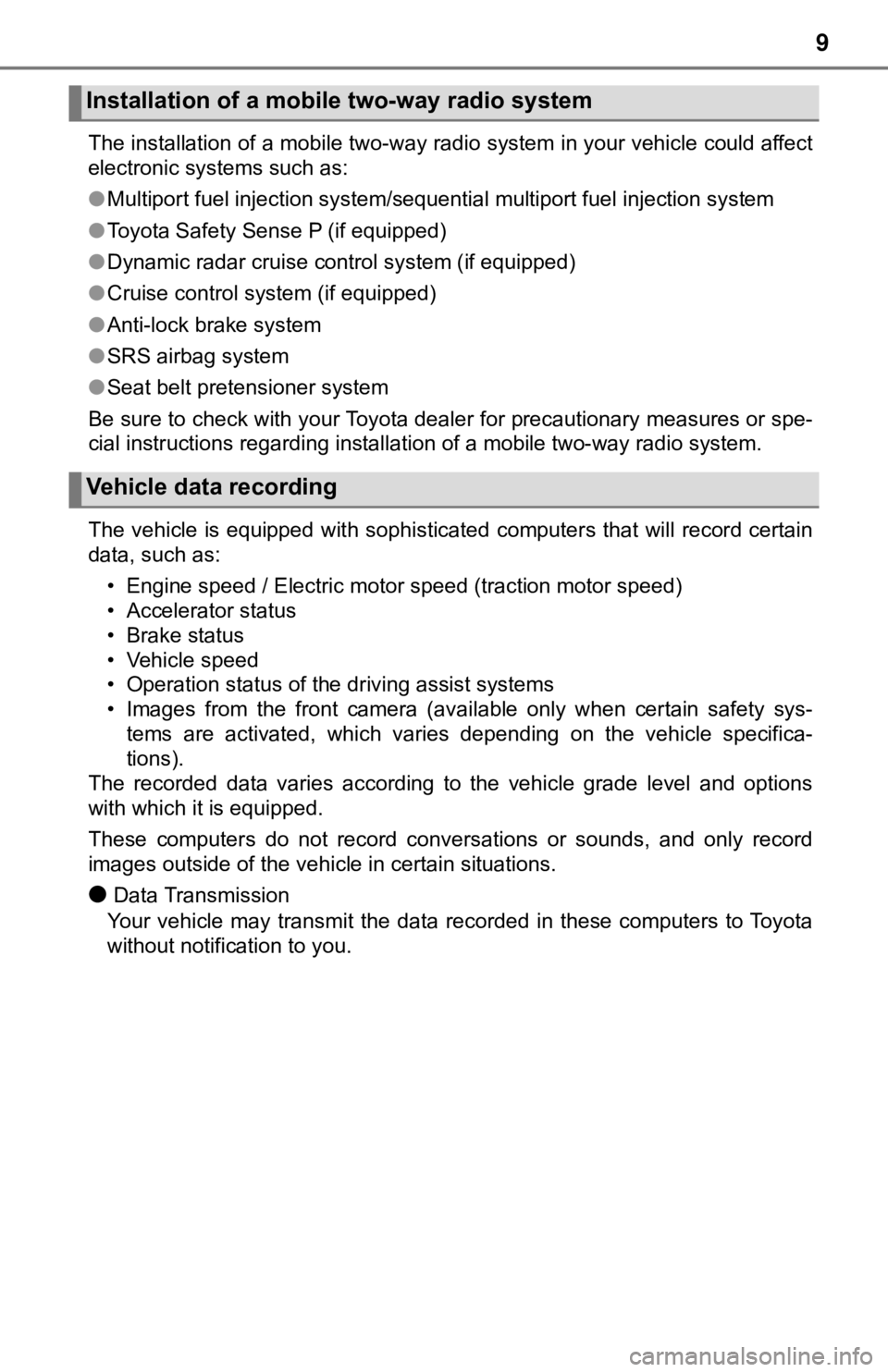
9
The installation of a mobile two-way radio system in your vehicle could affect
electronic systems such as:
● Multiport fuel injection system/sequential multiport fuel injection system
● Toyota Safety Sense P (if equipped)
● Dynamic radar cruise control system (if equipped)
● Cruise control system (if equipped)
● Anti-lock brake system
● SRS airbag system
● Seat belt pretensioner system
Be sure to check with your Toyota dealer for precautionary meas ures or spe-
cial instructions regarding instal lation of a mobile two-way radio system.
The vehicle is equipped with sophisticated computers that will record certain
data, such as:
• Engine speed / Electric motor speed (traction motor speed)
• Accelerator status
• Brake status
• Vehicle speed
• Operation status of the driving assist systems
• Images from the front camera (available only when certain safe ty sys-
tems are activated, which varies depending on the vehicle specifica-
tions).
The recorded data varies according to the vehicle grade level and options
with which it is equipped.
These computers do not record conversations or sounds, and only record
images outside of the vehicle in certain situations.
●Data Transmission
Your vehicle may transmit the data recorded in these computers to Toyota
without notification to you.
Installation of a mobile two-way radio system
Vehicle data recording
Page 11 of 616

11
This vehicle is equipped with an event data recorder (EDR). The main pur-
pose of an EDR is to record, in certain crash or near crash-lik e situations,
such as an air bag deployment or hitting a road obstacle, data that will assist
in understanding how a vehicle’s systems performed. The EDR is designed to
record data related to vehicle dynamics and safety systems for a short period
of time, typically 30 seconds or less.
The EDR in this vehicle is designed to record such data as:
• How various systems in your vehicle were operating;
• Whether or not the driver and passenger safety belts were buckled/fas-tened;
• How far (if at all) the driver was depressing the accelerator and/or brake
pedal; and,
• How fast the vehicle was traveling.
These data can help provide a better understanding of the circu mstances in
which crashes and injuries occur.
NOTE: EDR data are recorded by your vehicle only if a non-trivi al crash situ-
ation occurs; no data are recorded by the EDR under normal driv ing condi-
tions and no personal data (e.g., name, gender, age, and crash location) are
recorded. However, other parties, such as law enforcement, could combine
the EDR data with the type of personally identifying data routi nely acquired
during a crash investigation.
To read data recorded by an EDR, special equipment is required, and access
to the vehicle or the EDR is needed. In addition to the vehicle manufacturer,
other parties, such as law enforcement, that have the special e quipment, can
read the information if they have access to the vehicle or the EDR.
Event data recorder
Page 19 of 616
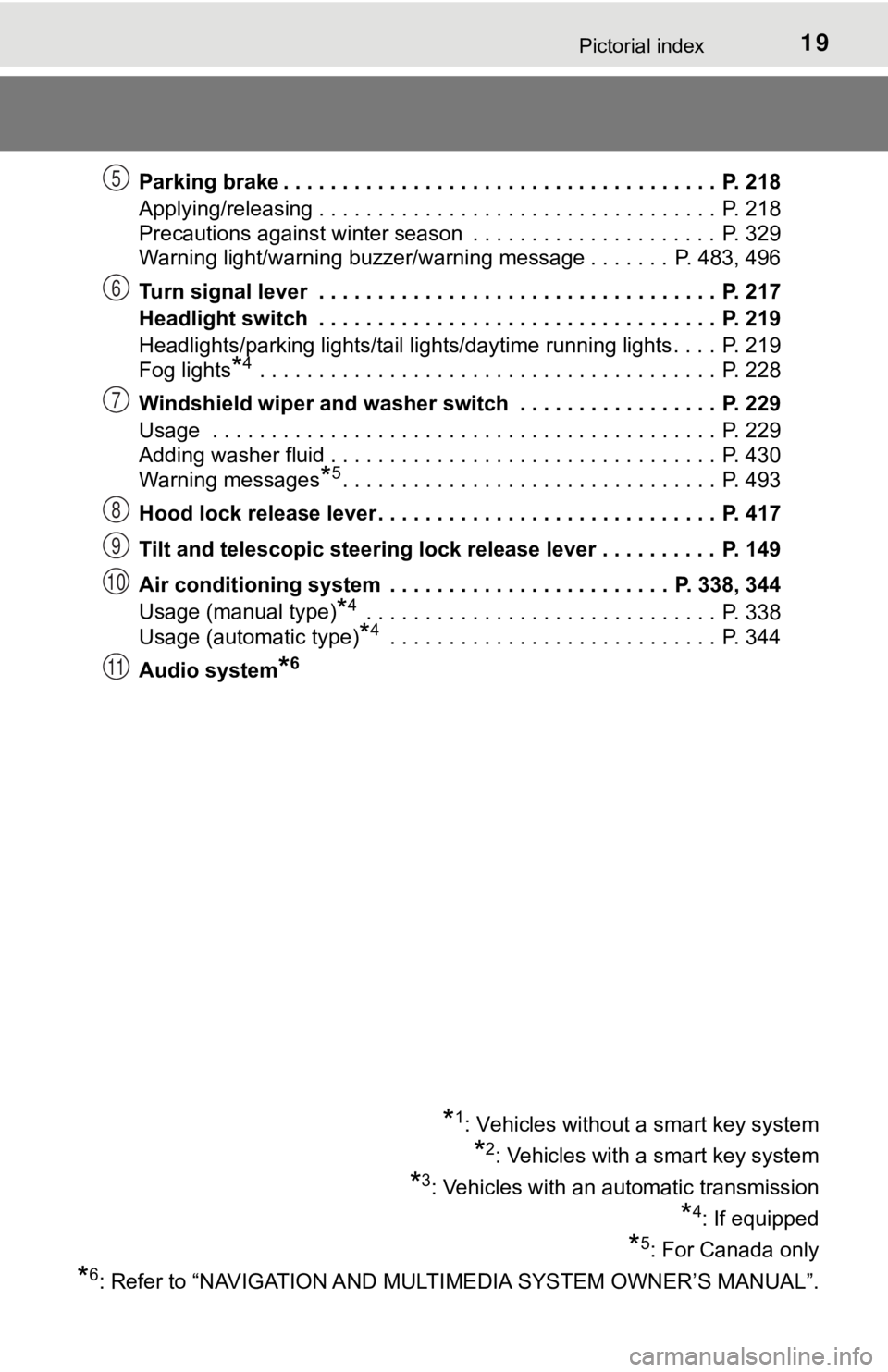
19Pictorial index
Parking brake . . . . . . . . . . . . . . . . . . . . . . . . . . . . . . . . . . . . . P. 218
Applying/releasing . . . . . . . . . . . . . . . . . . . . . . . . . . . . . . . . . . P. 218
Precautions against winter season . . . . . . . . . . . . . . . . . . . . . P. 329
Warning light/warning buzzer/warning message . . . . . . . P. 483, 496
Turn signal lever . . . . . . . . . . . . . . . . . . . . . . . . . . . . . . . . . . P. 217
Headlight switch . . . . . . . . . . . . . . . . . . . . . . . . . . . . . . . . . . P. 219
Headlights/parking lights/tail lights/daytime running lights . . . . P. 219
Fog lights
*4 . . . . . . . . . . . . . . . . . . . . . . . . . . . . . . . . . . . . . . . P. 228
Windshield wiper and washer switch . . . . . . . . . . . . . . . . . P. 229
Usage . . . . . . . . . . . . . . . . . . . . . . . . . . . . . . . . . . . . . . . . . . . P. 229
Adding washer fluid . . . . . . . . . . . . . . . . . . . . . . . . . . . . . . . . . P. 430
Warning messages
*5. . . . . . . . . . . . . . . . . . . . . . . . . . . . . . . . P. 493
Hood lock release lever. . . . . . . . . . . . . . . . . . . . . . . . . . . . . P. 417
Tilt and telescopic steering lock release lever . . . . . . . . . . P. 149
Air conditioning system . . . . . . . . . . . . . . . . . . . . . . . . P. 338, 344
Usage (manual type)
*4 . . . . . . . . . . . . . . . . . . . . . . . . . . . . . . P. 338
Usage (automatic type)
*4 . . . . . . . . . . . . . . . . . . . . . . . . . . . . P. 344
Audio system
*6
*1: Vehicles without a smart key system
*2: Vehicles with a smart key system
*3: Vehicles with an automatic transmission
*4: If equipped
*5: For Canada only
*6: Refer to “NAVIGATION AND MULTI MEDIA SYSTEM OWNER’S MANUAL”.
5
6
7
8
9
10
11
Page 93 of 616
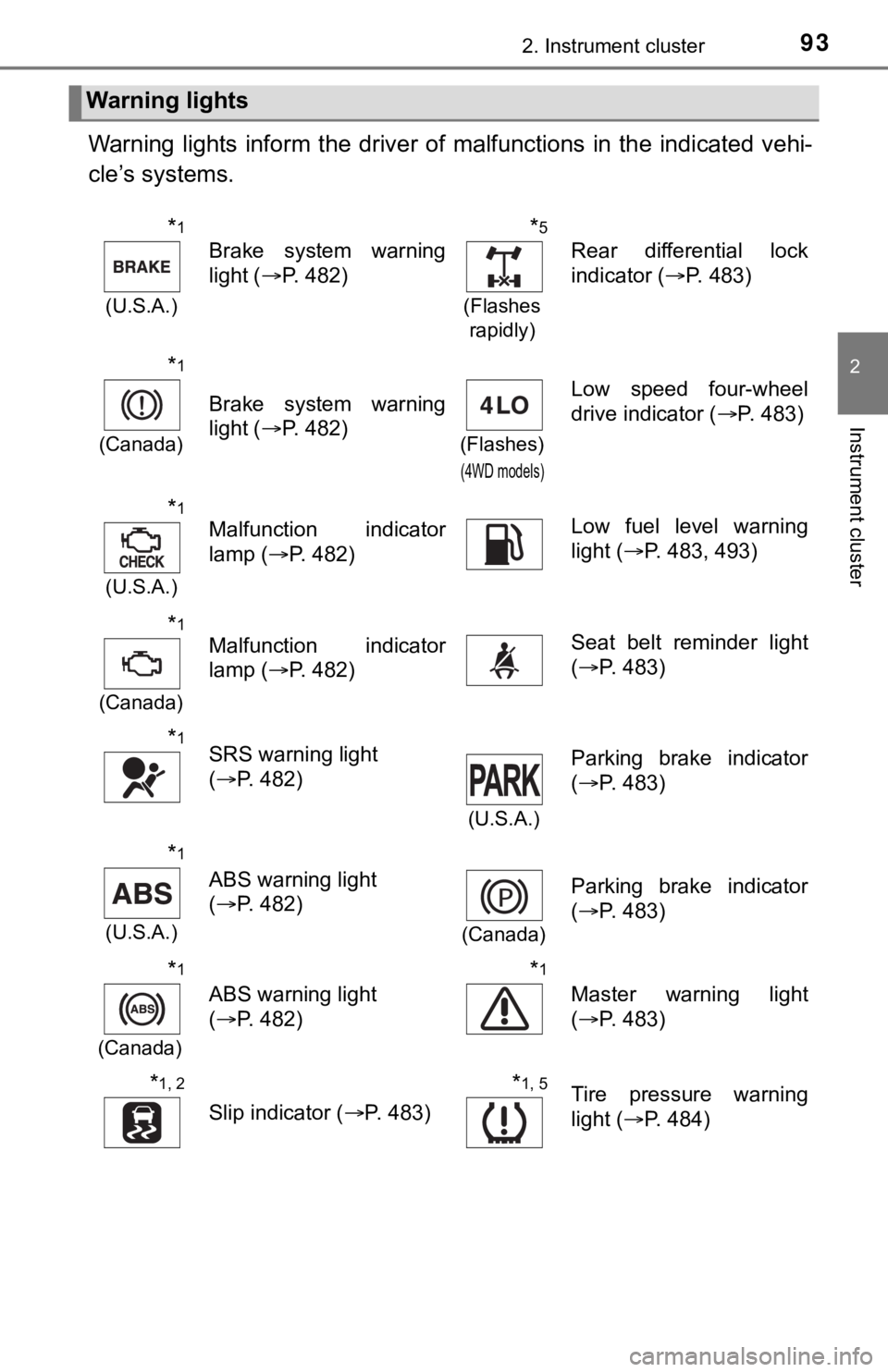
932. Instrument cluster
2
Instrument cluster
Warning lights inform the driver of malfunctions in the indicated vehi-
cle’s systems.
Warning lights
*1
(U.S.A.)
Brake system warning
light ( P. 482)
*5
(Flashes
rapidly)
Rear differential lock
indicator ( P. 483)
*1
(Canada)
Brake system warning
light ( P. 482)
(Flashes)
(4WD models)
Low speed four-wheel
drive indicator ( P. 483)
*1
(U.S.A.)
Malfunction indicator
lamp (P. 482)Low fuel level warning
light (P. 483, 493)
*1
(Canada)
Malfunction indicator
lamp ( P. 482)Seat belt reminder light
(P. 483)
*1SRS warning light
(P. 482)
(U.S.A.)
Parking brake indicator
(P. 483)
*1
(U.S.A.)
ABS warning light
(P. 482)
(Canada)
Parking brake indicator
(P. 483)
*1
(Canada)
ABS warning light
(P. 482)
*1
Master warning light
(P. 483)
*1, 2
Slip indicator ( P. 483)
*1, 5Tire pressure warning
light (P. 484)
Page 94 of 616
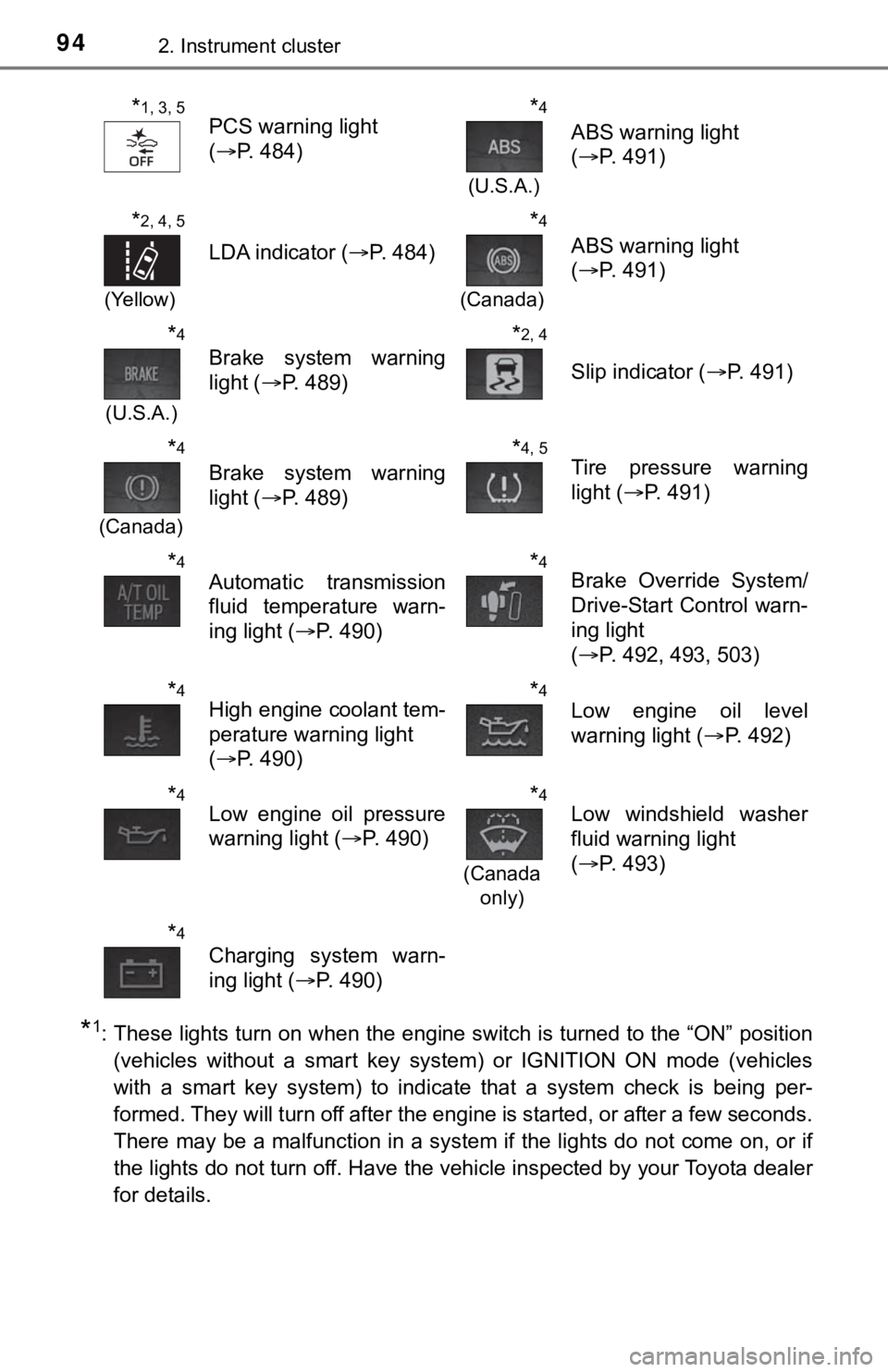
942. Instrument cluster
*1: These lights turn on when the engine switch is turned to the “ON” position(vehicles without a smart key system) or IGNITION ON mode (vehi cles
with a smart key system) to indicate that a system check is being per-
formed. They will turn off after the engine is started, or after a few seconds.
There may be a malfunction in a system if the lights do not com e on, or if
the lights do not turn off. Have the vehicle inspected by your Toyota dealer
for details.
*1, 3, 5PCS warning light
( P. 484)*4
(U.S.A.)
ABS warning light
(P. 491)
*2, 4, 5
(Yellow)
LDA indicator ( P. 484)
*4
(Canada)
ABS warning light
(P. 491)
*4
(U.S.A.)
Brake system warning
light ( P. 489)
*2, 4
Slip indicator ( P. 491)
*4
(Canada)
Brake system warning
light (P. 489)
*4, 5Tire pressure warning
light (P. 491)
*4Automatic transmission
fluid temperature warn-
ing light ( P. 490)*4Brake Override System/
Drive-Start Control warn-
ing light
(P. 492, 493, 503)
*4High engine coolant tem-
perature warning light
(P. 490)*4Low engine oil level
warning light ( P. 492)
*4Low engine oil pressure
warning light ( P. 490)*4
(Canada
only)
Low windshield washer
fluid warning light
(P. 493)
*4
Charging system warn-
ing light ( P. 490)
Page 96 of 616
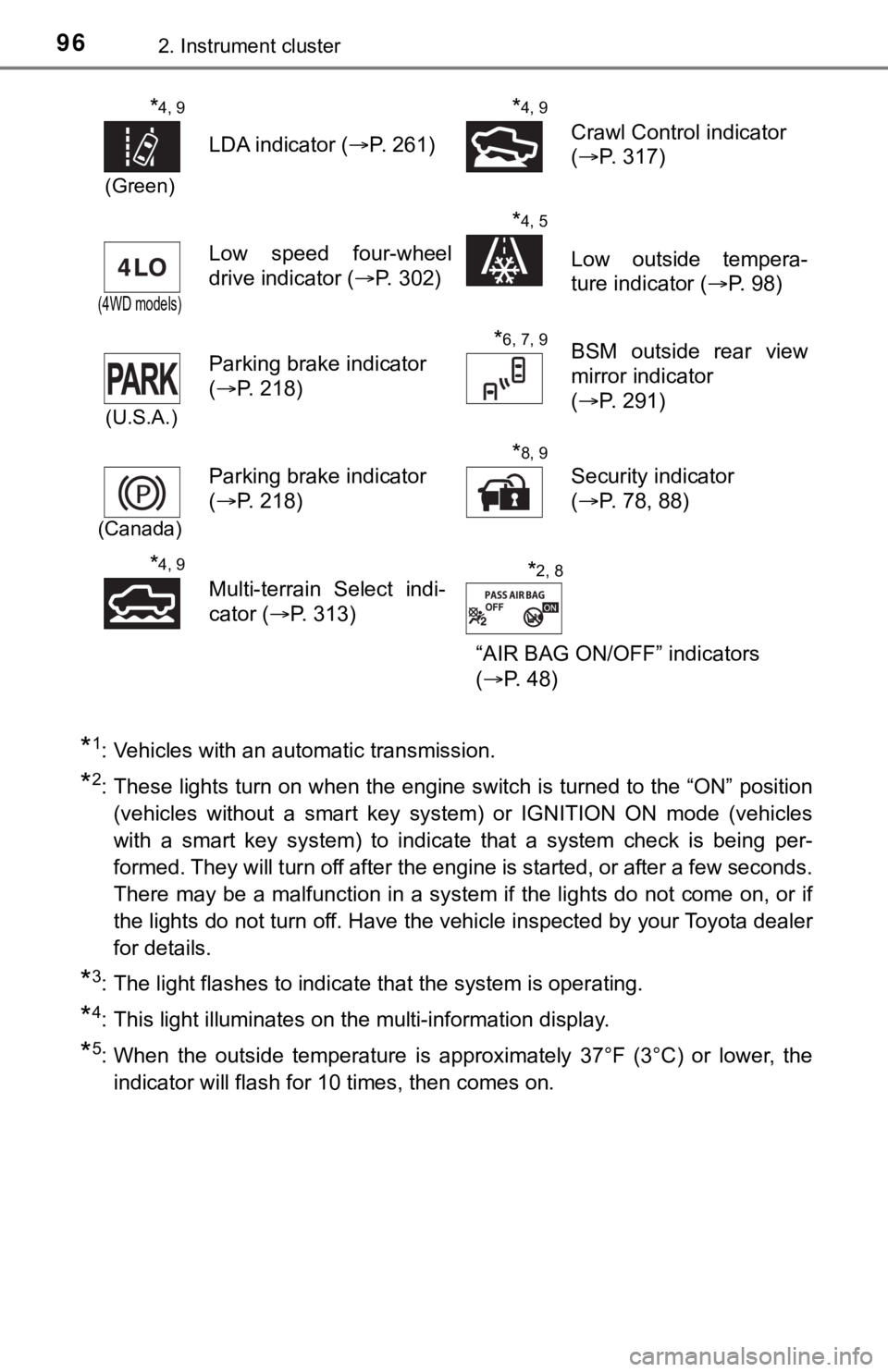
962. Instrument cluster
*1: Vehicles with an automatic transmission.
*2: These lights turn on when the engine switch is turned to the “ON” position(vehicles without a smart key system) or IGNITION ON mode (vehi cles
with a smart key system) to indicate that a system check is being per-
formed. They will turn off after the engine is started, or after a few seconds.
There may be a malfunction in a system if the lights do not com e on, or if
the lights do not turn off. Have the vehicle inspected by your Toyota dealer
for details.
*3: The light flashes to indicate that the system is operating.
*4: This light illuminates on the multi-information display.
*5: When the outside temperature is approximately 37°F (3°C) or lo wer, the
indicator will flash for 10 times, then comes on.
*4, 9
(Green)
LDA indicator ( P. 261)
*4, 9
Crawl Control indicator
(P. 317)
(4WD models)
Low speed four-wheel
drive indicator ( P. 302)
*4, 5
Low outside tempera-
ture indicator (P. 98)
(U.S.A.)
Parking brake indicator
(P. 218)
*6, 7, 9BSM outside rear view
mirror indicator
(P. 291)
(Canada)
Parking brake indicator
(P. 218)
*8, 9
Security indicator
(P. 78, 88)
*4, 9
Multi-terrain Select indi-
cator (P. 313)
“AIR BAG ON/OFF” indicators
(P. 48)*2, 8
Page 144 of 616

1443-3. Adjusting the seats
WARNING
■When raising the bottom cushion or fold the seatbacks down
Observe the following precautions.
Failure to do so may result in death or serious injury.
● Stop the vehicle on level ground, set the parking brake and shi ft the shift
lever to P (automatic transmission) or N (manual transmission).
Access Cab models
● Do not allow anyone to raise the bottom cushion while driving.
● Do not allow anyone to sit on the auxiliary box
Double Cab models
● Do not allow anyone to fold the seatbacks down while driving.
● Do not allow anyone to sit on the folded seatbacks while drivin g.
■ When returning the seats to their original position
Observe the following precautions.
Failure to do so may result in death or serious injury.
● Be careful not to get your hands or feet pinched in the seat.
Access Cab models
● Make sure the bottom cushions are securely locked.
Double Cab models
● Make sure the seatback is securely locked by pushing it forward and rear-
ward on the top.
● Check that the seat belts are not twisted or caught in the seat.
● Arrange the seat belts in the proper positions for ready use.
NOTICE
■Stowing the seat belts
The seat belts and the buckles must be stowed before you raise the bottom
cushion or fold down the rear seatbacks.
Page 166 of 616

166
4-1. Before drivingDriving the vehicle............. 168
Cargo and luggage ........... 178
Vehicle load limits ............. 182
Trailer towing .................... 183
Dinghy towing ................... 200
4-2. Driving procedures Engine (ignition) switch (vehicles without
a smart key system) ........ 201
Engine (ignition) switch (vehicles with a smart
key system)..................... 204
Automatic transmission ..... 210
Manual transmission ......... 215
Turn signal lever ............... 217
Parking brake .................... 218
4-3. Operating the lights and wipers
Headlight switch ................ 219
Automatic High Beam ....... 223
Fog light switch ................. 228
Windshield wipers and washer ............................ 229
4Driving
Page 168 of 616
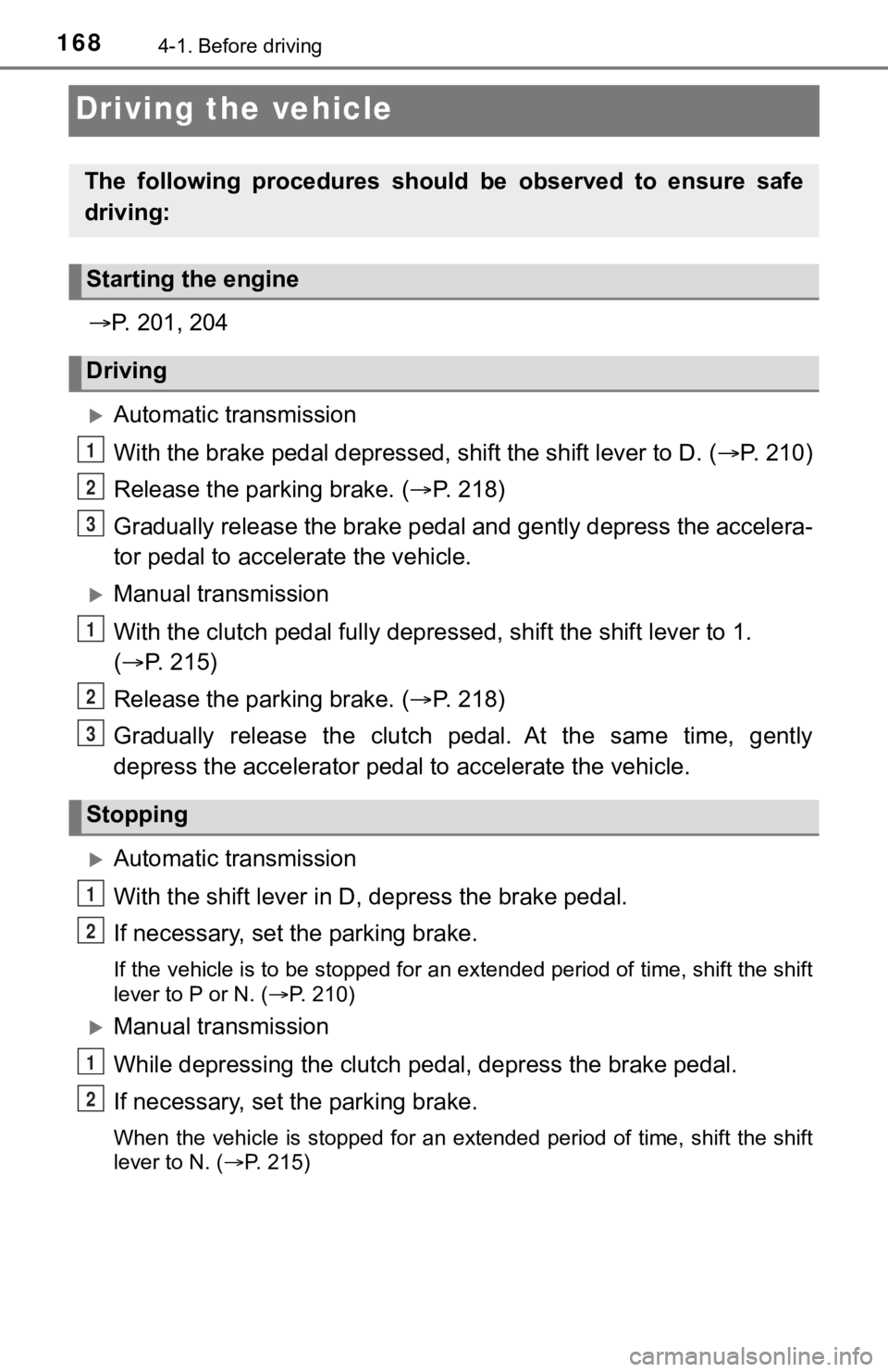
1684-1. Before driving
Driving the vehicle
P. 201, 204
Automatic transmission
With the brake pedal depressed, shift the shift lever to D. ( P. 2 1 0 )
Release the parking brake. ( P. 2 1 8 )
Gradually release the brake pedal and gently depress the accele ra-
tor pedal to accelerate the vehicle.
Manual transmission
With the clutch pedal fully depre ssed, shift the shift lever to 1.
( P. 215)
Release the parking brake. ( P. 2 1 8 )
Gradually release the clutch pedal. At the same time, gently
depress the accelerator pedal to accelerate the vehicle.
Automatic transmission
With the shift lever in D, depress the brake pedal.
If necessary, set the parking brake.
If the vehicle is to be stopped for an extended period of time, shift the shift
lever to P or N. ( P. 210)
Manual transmission
While depressing the clutch pedal, depress the brake pedal.
If necessary, set the parking brake.
When the vehicle is stopped for an extended period of time, shi ft the shift
lever to N. ( P. 215)
The following procedures should be observed to ensure safe
driving:
Starting the engine
Driving
Stopping
1
2
3
1
2
3
1
2
1
2